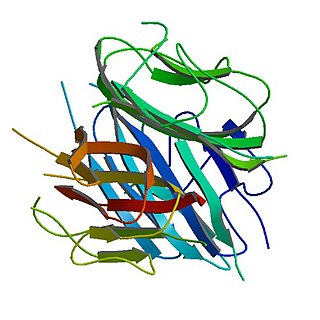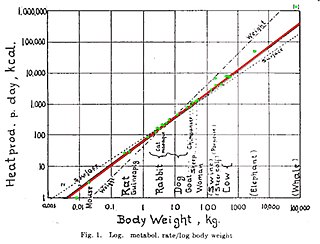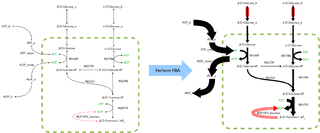Related Research Articles

Metabolism is the set of life-sustaining chemical reactions in organisms. The three main purposes of metabolism are: the conversion of food to energy to run cellular processes; the conversion of food/fuel to building blocks for proteins, lipids, nucleic acids, and some carbohydrates; and the elimination of nitrogenous wastes. These enzyme-catalyzed reactions allow organisms to grow and reproduce, maintain their structures, and respond to their environments..

Metabolic syndrome, sometimes known by other names, is a clustering of at least three of the five following medical conditions: central obesity, high blood pressure, high blood sugar, high serum triglycerides, and low serum high-density lipoprotein (HDL).
Insulin resistance (IR) is considered as a pathological condition in which cells fail to respond normally to the hormone insulin. To prevent hyperglycemia and noticeable organ damage over time, the body produces insulin when glucose starts to be released into the bloodstream, primarily from the digestion of carbohydrates in the diet. Under normal conditions of insulin reactivity, this insulin response triggers glucose being taken into body cells, to be used for energy, and inhibits the body from using fat for energy, thereby causing the concentration of glucose in the blood to decrease as a result, staying within the normal range even when a large amount of carbohydrates is consumed. Carbohydrates comprise simple sugars, i.e. monosaccharides, such as glucose and fructose, disaccharides, such as cane sugar, and polysaccharides, e.g. starches. Fructose, which is metabolised into triglycerides in the liver, stimulates insulin production through another mechanism, and can have a more potent effect than other carbohydrates. A habitually high intake of carbohydrates, and particularly fructose, e.g. with sweetened beverages, contributes to insulin resistance and has been linked to weight gain and obesity. If excess blood sugar is not sufficiently absorbed by cells even in the presence of insulin, the increase in the level of blood sugar can result in the classic hyperglycemic triad of polyphagia, polydipsia, and polyuria. Avoiding carbohydrates and sugars, a no-carbohydrate diet or fasting can reverse insulin resistance.
Isoleucine is an α-amino acid that is used in the biosynthesis of proteins. It contains an α-amino group, an α-carboxylic acid group, and a hydrocarbon side chain, classifying it as a non-polar, uncharged, aliphatic amino acid. It is essential in humans, meaning the body cannot synthesize it, and must be ingested in our diet. Isoleucine is synthesized from pyruvate employing leucine biosynthesis enzymes in other organisms such as bacteria. It is encoded by the codons ATT, ATC, and ATA.
Valine (symbol Val or V) is an α-amino acid that is used in the biosynthesis of proteins. It contains an α-amino group (which is in the protonated −NH3+ form under biological conditions), an α-carboxylic acid group (which is in the deprotonated −COO− form under biological conditions), and a side chain isopropyl group, making it a non-polar aliphatic amino acid. It is essential in humans, meaning the body cannot synthesize it: it must be obtained from the diet. Human dietary sources are foods that contain protein, such as meats, dairy products, soy products, beans and legumes. It is encoded by all codons starting with GU (GUU, GUC, GUA, and GUG).
A xenobiotic is a chemical substance found within an organism that is not naturally produced or expected to be present within the organism. It can also cover substances that are present in much higher concentrations than are usual.
Basal metabolic rate (BMR) is the rate of energy expenditure per unit time by endothermic animals at rest. It is reported in energy units per unit time ranging from watt (joule/second) to ml O2/min or joule per hour per kg body mass J/(h·kg). Proper measurement requires a strict set of criteria be met. These criteria include being in a physically and psychologically undisturbed state, in a thermally neutral environment, while in the post-absorptive state (i.e., not actively digesting food). In bradymetabolic animals, such as fish and reptiles, the equivalent term standard metabolic rate (SMR) is used. It follows the same criteria as BMR, but requires the documentation of the temperature at which the metabolic rate was measured. This makes BMR a variant of standard metabolic rate measurement that excludes the temperature data, a practice that has led to problems in defining "standard" rates of metabolism for many mammals.

Adiponectin is a protein hormone which is involved in regulating glucose levels as well as fatty acid breakdown. In humans it is encoded by the ADIPOQ gene and it is produced in adipose tissue.

Drug metabolism is the metabolic breakdown of drugs by living organisms, usually through specialized enzymatic systems. More generally, xenobiotic metabolism is the set of metabolic pathways that modify the chemical structure of xenobiotics, which are compounds foreign to an organism's normal biochemistry, such as any drug or poison. These pathways are a form of biotransformation present in all major groups of organisms, and are considered to be of ancient origin. These reactions often act to detoxify poisonous compounds. The study of drug metabolism is called pharmacokinetics.

Kleiber's law, named after Max Kleiber for his biology work in the early 1930s, is the observation that, for the vast majority of animals, an animal's metabolic rate scales to the ¾ power of the animal's mass. Symbolically: if q0 is the animal's metabolic rate, and M the animal's mass, then Kleiber's law states that q0 ~ M¾. Thus, over the same timespan, a cat having a mass 100 times that of a mouse will consume only about 32 times the energy the mouse uses.

Metabolic engineering is the practice of optimizing genetic and regulatory processes within cells to increase the cells' production of a certain substance. These processes are chemical networks that use a series of biochemical reactions and enzymes that allow cells to convert raw materials into molecules necessary for the cell’s survival. Metabolic engineering specifically seeks to mathematically model these networks, calculate a yield of useful products, and pin point parts of the network that constrain the production of these products. Genetic engineering techniques can then be used to modify the network in order to relieve these constraints. Once again this modified network can be modeled to calculate the new product yield.

Allometry is the study of the relationship of body size to shape, anatomy, physiology and finally behaviour, first outlined by Otto Snell in 1892, by D'Arcy Thompson in 1917 in On Growth and Form and by Julian Huxley in 1932.

Metabolic network reconstruction and simulation allows for an in-depth insight into the molecular mechanisms of a particular organism. In particular, these models correlate the genome with molecular physiology. A reconstruction breaks down metabolic pathways into their respective reactions and enzymes, and analyzes them within the perspective of the entire network. In simplified terms, a reconstruction collects all of the relevant metabolic information of an organism and compiles it in a mathematical model. Validation and analysis of reconstructions can allow identification of key features of metabolism such as growth yield, resource distribution, network robustness, and gene essentiality. This knowledge can then be applied to create novel biotechnology.

Flux balance analysis (FBA) is a mathematical method for simulating metabolism in genome-scale reconstructions of metabolic networks. In comparison to traditional methods of modeling, FBA is less intensive in terms of the input data required for constructing the model. Simulations performed using FBA are computationally inexpensive and can calculate steady-state metabolic fluxes for large models in a few seconds on modern personal computers.

D-Xylose is a five-carbon aldose that can be catabolized or metabolized into useful products by a variety of organisms.
Metabolic intermediates are molecules which are the precursors or metabolites of biologically significant molecules.
Deployment cost–benefit selection in physiology concerns the costs and benefits of physiological process that can be deployed and selected in regard to whether they will increase or not an animal’s survival and biological fitness. Variably deployable physiological processes relate mostly to processes that defend or clear infections as these are optional while also having high costs and circumstance linked benefits. They include immune system responses, fever, antioxidants and the plasma level of iron. Notable determining factors are life history stage, and resource availability.
The energy cost of transport quantifies the energy efficiency of transporting an animal or vehicle from one place to another. As a dimensionless quantity, it allows for the comparison of dissimilar animals or modes of transportation. It has a wide range of applications, from comparing human gaits to observing the change in efficiency of trains over time.
The minimum depth of occurrence (MDO) is the shallowest depth in the ocean at which a species is observed. Because some aberrant individuals often can be found far outside their typical depth range, the MDO is sometimes defined as the depth below which 90% of individuals are observed or captured. In practice, observations of pelagic organisms are limited to trawling at a known depth, scuba diving observations, or use of underwater vehicles such as ROVs or AUVs. A species' MDO can change throughout ontogeny if the species is an ontogenetic vertical migrator; that is, it changes its habitat depth as it matures. Additionally, some species undergo diel vertical migration in which they migrate vertically each day. In these taxa, the MDO is defined based on their shallowest depth during their diel migration.
References
- ↑ The biological cost of antimicrobial resistance Stephen H. Gillespie*, and Timothy D. McHugh
- ↑ Wichelhaus TA, Böddinghaus B, Besier S, Schäfer V, Brade V, Ludwig A (2002). "Biological cost of rifampin resistance from the perspective of Staphylococcus aureus". Antimicrob. Agents Chemother. 46 (11): 3381–5. doi:10.1128/AAC.46.11.3381-3385.2002. PMC 128759 . PMID 12384339.
| This biology article is a stub. You can help Wikipedia by expanding it. |